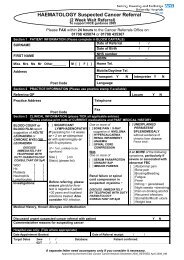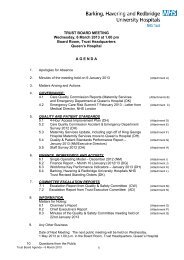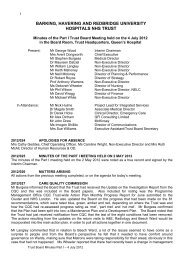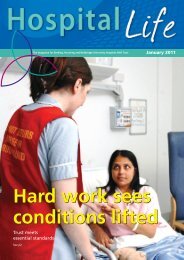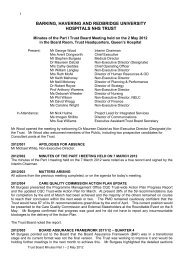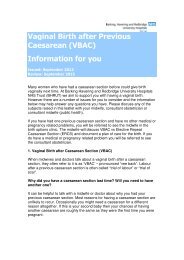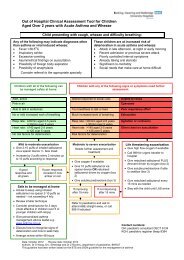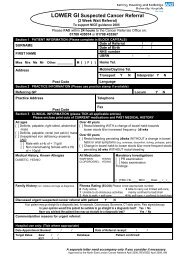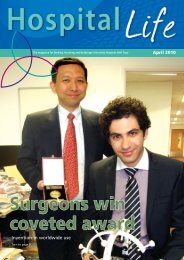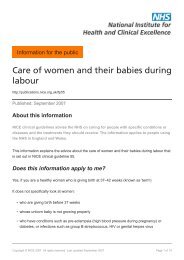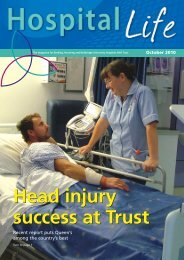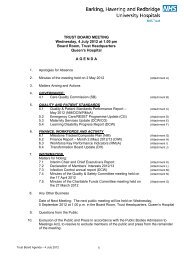BHRUT annual report 2010 - Barking Havering and Redbridge ...
BHRUT annual report 2010 - Barking Havering and Redbridge ...
BHRUT annual report 2010 - Barking Havering and Redbridge ...
Create successful ePaper yourself
Turn your PDF publications into a flip-book with our unique Google optimized e-Paper software.
Annual Report<strong>and</strong>Accounts<strong>2010</strong>/11
Welcome from the Chief Executive <strong>and</strong> ChairmanWelcome to our Annual Report for <strong>2010</strong>/11.We hope that this <strong>report</strong> will give you a real flavour of the enormous amountof work taking place at our hospitals to deliver the best possible care to ourpopulation.We have seen many developments in the past year, <strong>and</strong> had great success incertain areas. But there have also been challenges, <strong>and</strong> services that haveneeded particular attention.We have continued to work hard to reduce our deficit <strong>and</strong> to deliver our CostImprovement Programme. New ways of working led to savings of £23 millionover the year, although this was still some way off our target of more than £35million.Major cost savings still need to be made this financial year, with our dedicatedstaff ensuring that patient care <strong>and</strong> services continue to improve.We are working closely with our partners <strong>and</strong> the Department of Health toensure that we reach our target for breaking even, <strong>and</strong> can therefore worktowards achieving Foundation Trust status.The Trust was registered with eight conditions by the Care QualityCommission during the year. These conditions have been helpful in focusingour efforts in making key improvements. Despite several of these conditionsnow being lifted by the CQC <strong>and</strong> evidence of improvements in all areas, thereis no complacency at the Trust about the need to improve quality, <strong>and</strong> tocontinue to deliver quality care in every clinical area.This is particularly the case in our Maternity department, where attracting <strong>and</strong>retaining trained staff is a continuing challenge. The CQC issued a warningnotice requiring improvements in Maternity in March 2011, <strong>and</strong> we areworking with staff <strong>and</strong> local women to ensure that their concerns areaddressed so that we can rebuild confidence in the quality of our services.Dem<strong>and</strong> across the board means that we are still struggling to reach thest<strong>and</strong>ards we would like in certain areas, such as waiting times in ourAccident <strong>and</strong> Emergency departments.But it is important that the challenges we are facing in some areas do notovershadow the genuinely outst<strong>and</strong>ing care which we achieve in others.To cut our use of agency staff – <strong>and</strong> therefore to improve continuity of care forour patients – we have focussed on recruiting permanent front-line staff thisyear.
Major recruitment drives have seen highly qualified nurses <strong>and</strong> midwives joinour hospitals, along with experienced therapists <strong>and</strong> consultants.We are confident that we have high calibre staff on our wards who willcontinue to work towards our aims of ensuring that patients have the bestpossible experience of our services.We have both joined the Trust this year – replacing Sir David Varney asChairman <strong>and</strong> John Goulston as Chief Executive – <strong>and</strong> have been struck bythe hard work <strong>and</strong> dedication of our staff <strong>and</strong> volunteers.We are determined that, with their support <strong>and</strong> that of our partners <strong>and</strong>stakeholders, we can continue to move forward, tackle challenges head-on,<strong>and</strong> be proud of the service we provide to our patients.Edwin DoyleChairmanAveril DongworthChief Executive
Key StatisticsServing 750,000 people from a variety of backgrounds <strong>and</strong> across a widearea, this Trust is one of the largest in the country.We deliver services from two large district general hospitals – Queen’s inRomford <strong>and</strong> King George in Goodmayes.Our staff work hard to ensure that patient care is at the heart of everything wedo – despite the extremely high numbers of people we treat every day of theyear.Between April <strong>2010</strong> <strong>and</strong> March 2011, the Trust recorded the following activity:OutpatientsKing George h<strong>and</strong>led 51,672 new outpatient appointments, with another114,658 follow-up appointments – a total of 166,330 booked appointments.Queen’s saw 110,158 new <strong>and</strong> 283,160 follow-up outpatient appointments – atotal of 393,318.The Trust as a whole dealt with 684,605 booked outpatient appointmentsacross all the sites where it operates clinics.A&E attendancesKing George saw 76,671 A&E attendances last year, whilst Queen’s had103,903 people through the doors.That is a total of 180,574 attendances at our Accident <strong>and</strong> Emergencydepartments.BirthsMidwives at King George delivered 2,042 babies, with another 7,681 beingborn at Queen’s.Including home births, the total number of babies born was 9,931.InpatientsKing George had 45,069 inpatient admissions during the year, with 84,235patients staying at Queen’s.Inpatient admissions across the Trust totalled 129,530.
Hitting the targetsLike all Trusts, we work to meet national targets which are set down by theGovernment. These cover a wide range of services, <strong>and</strong> include the maximumamount of time people should wait to be treated.We have worked extremely hard this year to improve waiting times, althoughthis is still an issue in some areas.The table below sets out our performance over the year.Existing <strong>and</strong> NationalPriorities18 week referral to treatment waiting timesAdmittedNon-admittedA&E waiting times4-Hour max. wait in A&E from arrival toadmission, transfer or dischargeAccess to genito-urinary medicine (GUM)clinicsCancer urgent referral to first outpatientappointment waiting times2-Week GP referral to first outpatientappointmentCancelled operationsCancelled operations not re-admitted within28 days<strong>2010</strong>/11 PerformanceTarget 2008/09 2009/10 <strong>2010</strong>/11Nolonger atarget93.52%96.94%(Q4<strong>report</strong>ingperiod)91.44%95.73%(April–Feb)Nolonger atargetQ1=98%Q2-4=95%96.02% 97.31% 95.30%98% 99.16% 99.93% 99.06%93% 99.00% 99.75% 96.65%5% 2.87% 2.33% 2.65%(Apr-Feb)Cancer diagnosis to treatment waiting times31 Day diagnosis to treatment – all cancers 96% 95.40% 96.89% 99.90%Cancer urgent referral to treatment waitingtimes62 Day urgent referral to treatment – allcancers85% 82.10% 81.62% 83.69%
Existing <strong>and</strong> NationalPriorities (Continued)Clostridium difficile infections<strong>2010</strong>/11 PerformanceTarget 2008/09 2009/10 <strong>2010</strong>/11Seeindividualtargets ineachcolumn.Casesidentified126Max. No.of cases 2Casesidentified82Max. No.of cases 2Casesidentified110Max.of cases 2128219 145The Department of Health given number for that period for both GPs, residential homes, communityhospitals <strong>and</strong> the Trust was no more the 597. Only 218 cases were identified.Department of Health guidance changed splitting acute trust numbers from community numbersidentifying hospital acquired <strong>and</strong> community acquired infection.Delayed transfers of carePercentage of inpatients withdelayed transfer of careEngagement in clinical auditsLocalNational3.5% 2.63% 3.78% 4.28%ogets3193234744Ethnic coding data qualityEthnicity recorded for all inpatients 95% 94.90% 96.34%(April-Feb)Inpatients waiting longer than the 25 weekst<strong>and</strong>ardMRSA bacteraemias 3The ‘cases identified’ figures are thosenumbers of patients who acquired MRSA <strong>and</strong>the ‘maximum numbers’ shown are thoseallowed under the Department of Healthtargets.Outpatients waiting longer than the 13 weekst<strong>and</strong>ardNolonger atargetSeeindividualtargets ineachcolumn.3844997.74%No.75 1 Nolonger atargetCasesidentified37Max.of cases40No.Casesidentified28Max.of cases39No.Casesidentified15Max.of cases11Nolonger atarget6 0 Nolonger atargetParticipation in heart disease audits N/A Yes Yes YesNo.
Celebrating our peopleStaff HonoredThis year saw the Trust’s fourth Outst<strong>and</strong>ing Achievement Awards.The awards were devised to recognise <strong>and</strong> celebrate outst<strong>and</strong>ing individual orteam achievement <strong>and</strong> performance.Top staff from departments <strong>and</strong> services across the Trust were honored at the<strong>annual</strong> awards ceremony.Taking the prize for Outst<strong>and</strong>ing Patient Care was Janet Copp – ClinicalNurse Specialist in Haematology <strong>and</strong> Oncology.The packed ceremony held at Queen’s Hospital heard how she workstirelessly to ensure that patients are put at their ease, making herself availableday <strong>and</strong> night to talk to them on the phone <strong>and</strong> allay any concerns they mayhave.In the Working Smarter, Not Harder category, matrons Cathy Dunne <strong>and</strong>Pauline Osborn took top honors for developing the Virtual Ward.The scheme helps patients either avoid admission to hospital, or to enjoy areduced length of stay, by developing services in their own home.Leading the Trust through the swine flu p<strong>and</strong>emic won Sheila O’Mahony theUnsung Hero award.Sheila, the Trust’s Head of Infection Control, became Flu Director during theoutbreak, developing <strong>and</strong> implementing a p<strong>and</strong>emic flu plan which saw bothhospitals through the potential crisis.
Taking the Unsung Hero Award for the Trust’s partner organisations was thesecurity team at Queen’s Hospital – employed by Sodexo.The trained experts on the front line regularly have to deal with confrontation<strong>and</strong> difficult situations, but have built up a strong reputation for beingapproachable <strong>and</strong> helpful at all times.Porter George Chennells was named as the Employee of the Year – chosenfrom the Trust’s 12 Employees of the Month.Countless Accident <strong>and</strong> Emergency department staff put him forward for thehonour.Volunteers ThankedA couple who give up their free time to visit hospital patients became therecipients of a special appreciation award.Vivien <strong>and</strong> Alan Fitch began visiting patients at King George Hospital back in2000. They now also visit patients at Queen’s Hospital.The pair were nominated for the award by Trust Volunteer Co-Ordinator, JeanThompson, who said: “Vivien <strong>and</strong> Alan visit the wards each week to talk topatients <strong>and</strong> keep them company.“This is particularly beneficial when a patient has no relatives living nearby.The patients <strong>and</strong> their relatives are always so grateful to them for the timethey give up - <strong>and</strong> that has a positive effect on their recovery.”Vivien <strong>and</strong> Alan were presented a Volunteer Appreciation Award by the Trust.
New developmentsAcute Elderly UnitThe Trust opened its Acute Elderly Unit this year, with impressive results.The 90-bed unit stretches across three wards at Queen’s Hospital, with a 30-bed dedicated acute rehabilitation ward at King George.Patients over the age of 80 – or those over 70 with complex elderly needs –are now cared for in the unit by specialist staff.All patients are seen by an elderly care specialist on arrival, <strong>and</strong> there aredouble the usual number of therapists on h<strong>and</strong> to help with rehabilitation.The success of the unit has been astonishing.Within weeks of the unit opening in June the number of falls was cut by half,the number of pressure ulcers reduced by 30%, <strong>and</strong> the recording of patients’vital signs went up by 35%.Elderly patients are recovering so well in the Acute Unit that, in just nineweeks, the average length of stay fell by two days.All of the wards have a dedicated nutrition assistant who makes sure thatpeople are getting the food <strong>and</strong> drink that they need.
And nurses make sure that they visit every patient regularly <strong>and</strong> do regularreviews of their condition.The Trust is working to improve care of the elderly across the board, <strong>and</strong> is inlinewith national strategies for the care of older people <strong>and</strong> treating dementia.Groups have been set up to review pain assessment <strong>and</strong> management, toimprove the promotion of continence <strong>and</strong> to improve patient experience.Dignity champions have also been put in place to ensure that patients aretreated with respect, <strong>and</strong> a Productive Ward scheme has been introducedwhich has seen nurses’ direct patient care time increased by 12%.Matron Jackie Wray said: “By cohorting elderly patients within these areas,they have greatly enhanced services. It is a specific focus for social services<strong>and</strong> the discharge team so that patients can be moved home, or into a carehome, as soon as they are ready.“There is also be mental health liaison nurses based on the unit so that theycan work closely with people suffering from dementia.”Stroke CareThe new Hyper Acute Stroke Unit at Queen’s became the first in London to befully operation last summer.Patients now have access to specialist techniques <strong>and</strong> care 24 hours a day –leading to much better outcomes.The Unit has been extremely successful <strong>and</strong> a National Sentinel Stroke Auditshowed that it is delivering top quality care.
The Queen’s HASU was rated in the top quarter across the whole country,<strong>and</strong> was given the highest possible rating for the quality of the care itprovides.Two years ago it was among the worst performing in Engl<strong>and</strong>. A year later theservice had improved enough to move it into the middle category, <strong>and</strong> in <strong>2010</strong>it was one of the best.Consultant stroke physician Khaled Darawil said: “These results are veryimpressive. Our rating has improved year-on-year <strong>and</strong> we are now giving ourpatients some of the best care in the whole country.”The new unit is one of eight across London which provides patients with 24/7access to specialist stroke staff, the latest CT scanning equipment <strong>and</strong> clotbusting drugs (thrombolysis).Each year around 11,000 people suffer a stroke in London, making it thesecond biggest killer in the capital <strong>and</strong> the most common cause of disability.The introduction of the eight HASUs is expected to save around 400 lives ayear.As well as expert emergency care, the Trust also has a dedicatedrehabilitation service for stroke patients to get them back on their feet <strong>and</strong>reduce long-term disabilities.The Trust has also become the first NHS organisation ever to be given a LifeAfter Stroke Award.The Stroke Association named the Trust as having the Most Improved StrokeService in the country.Sexual Health
A new, state-of-the-art sexual health centre has opened its doors to thepublic.The Sydenham Centre has moved into a new building on the <strong>Barking</strong> Hospitalsite.The new facilities – built to the Trust’s specifications - are spread across twofloors, including extra consultation rooms, laboratory space, a pharmacy,phlebotomy areas, counselling rooms <strong>and</strong> offices.The extra space <strong>and</strong> more congenial environment will be appreciated by thehundreds of patients who use the Centre every week.It has allowed the Trust to provide extra HIV clinics. Previously three clinicswere run a week – now there are four. There are also special roomsspecifically for talking to patients about their medication, <strong>and</strong> the importanceof taking it regularly.Community support teams, who work with HIV patients, are based at thecentre, <strong>and</strong> an on-line forum has also been set up for clinic patients.The forum gives people with HIV the chance to talk to other people in thesame situation to they can share experiences <strong>and</strong> support each other.The Sydenham Centre is an integrated sexual health <strong>and</strong> family planningservice, so as well as diagnosing <strong>and</strong> treating STIs, the trained advisors alsodeal with contraceptive services.The local population has high levels of teenage pregnancy <strong>and</strong> repeatabortions, <strong>and</strong> the Trust is working hard to tackle the problem.As well as the community support team, health advisors, nurses <strong>and</strong> a sexualhealth Consultant are all based at the centre.A walk-in service is now available every weekday except Wednesdays, sopeople don’t have to make an appointment for sexual health or familyplanning issues. And with both services on site, someone arriving for STIscreening can also receive advice on contraceptives at the same time.“This is such a busy centre,” said General Manager Maureen Ross, “but wenow have so much space here that we can grow with the population <strong>and</strong> theneeds of the service.”
Trauma Team SuccessThe trauma team at Queen’s Hospital has been praised for playing a vital partin a Trauma Network.The Accident <strong>and</strong> Emergency department at Queen’s forms part of the NorthEast London <strong>and</strong> Essex Trauma Network – launched in April <strong>2010</strong>.Trauma centres across the region had been working towards the launch fortwo years – aiming to give patients the best possible emergency care.Now, if someone suffers are a traumatic injury, they will be taken directly tothe very best A&E department for their needs.The region’s Multi Trauma Centre is at the Royal London Hospital. ButQueen’s houses a Specialist Trauma Unit for head, facial <strong>and</strong> spinal injuries.If a patient has major injuries to their head, neck or spine they will be broughtdirectly to the Romford hospital. Previously they would have been taken totheir nearest A&E before being transferred to Queen’s for specialist treatment.Arriving directly at a neurosurgical centre means that the time from injury topotentially life-saving surgery is minimised. Patients also have access to theexpertise of the neuro-intensive care team who ensure that patients withacute brain or spinal injuries receive the highest st<strong>and</strong>ard of management.The first performance assessment of the Trauma Network has taken place,<strong>and</strong> shows that it is proving extremely successful <strong>and</strong> improving care <strong>and</strong>outcomes for patients.Acting Director of Trauma Derek Hicks said: “The Network is workingextremely well. We are getting the right patients brought to us first time.“With specialist knowledge of head, facial <strong>and</strong> spinal injuries, patients havebetter outcomes if they come to us directly. The focus of the team on head
<strong>and</strong> spinal injuries means that they are attentive to the small things that canmake a big difference in the long term.”The radiographers working with the trauma team at Queen’s ensure thatpatients arriving at the hospital are given a CT scan in an average of just 35minutes. The national target is 60 minutes.Improving patient experienceThe Trust continues to work hard to improve the experience of patients whilethey are in our hospitals.There is far more to hospital care than ensuring that people receive the bestclinical treatment.It is also important that they feel listened too, <strong>and</strong> are treated with privacy <strong>and</strong>dignity as a valued individual.Our Visible Leadership scheme – with senior nursing staff back on the wardsone day a week – is still proving very successful in highlighting areas ofimprovement. Senior staff – including our Director of Nursing – join a ward tolook at key indicators of patient care, including h<strong>and</strong> hygiene <strong>and</strong> nutritionassessment.In the past year the scheme has seen impressive results, with improvementsacross the board.The Productive Ward programme has made a big difference to meal timesthis year.A dedicated Healthcare Support Worker now prepares patients for theirmeals, new colour-coded boards help the hostess to underst<strong>and</strong> a patient’sdietary requirements, <strong>and</strong> there is more help available for those who havedifficulty feeding themselves.Where possible, people are also given the chance to sit at a dining table <strong>and</strong>eat with other patients.The changes have made mealtimes much quicker, meaning that staff havemore time to spend on direct patient care.We continue to treat patients in single sex areas to ensure their dignity, <strong>and</strong>work closely with the patient representatives on our Improving PatientExperience Group to ensure they are fully involved in the development ofTrust services.
The national survey of NHS patients helps us to identify where people feel weare doing well, <strong>and</strong> which areas they feel we could improve.This year we have introduced our own patient survey, so people can useh<strong>and</strong>-held computers or static kiosks at both hospitals to give us feedback onour services there <strong>and</strong> then.We can access results regularly, so can act on patients’ opinions toimplement changes quickly <strong>and</strong> effectively.Patient Experience 2008/9 2009/10 <strong>2010</strong>/11 TargetNumber of formal complaints 940 566 660 539receivedNumber of Patient Advice <strong>and</strong> 8,209 9.988 7,218 No targetLiaison Service enquiriesPercentage of patients who 70% 72% 74% No targetalways feel they were treatedwith dignity <strong>and</strong> respect (AnnualInpatient Survey)Percentage of patients who 63% 64% 67% No targetwere always given enoughprivacy when discussing theircondition or treatment
Our StaffThe Trust employs more than 5,000 Full Times Equivalent (FTE) staff, whoare our most important resource. Around 70 per cent of them work in directclinical care, with a further 11 per cent in clinical support roles.Without our skilled <strong>and</strong> dedicated workforce we could not continue to make adifference to the people who need to use our services.From March 1 st <strong>2010</strong> to February 28 th 2011 our actual number of FTE staff inpost increased by more than 141. The change was due to successfulrecruitment campaigns which have significantly increased the number of frontlinestaff working directly with patients on our wards.This means we can reduce our use of agency staff <strong>and</strong> locums, improvingcontinuity of care for patients.<strong>Barking</strong>, <strong>Havering</strong> & <strong>Redbridge</strong> University Hospitals NHS Trust - Staff In Post - Full Time Equivalents(FTE's) - As at 28th February 2011Other Qualified Nurses,1475.19, 30%Ancillary & Non-patient-careSWkrs,27.00, 1%Professional, Technical &Scientific,522.13, 10%Unq Nurses & Patient-careSWkrs,671.74, 13%Midw ives,253.19, 5%Medical - TrainingGrades, 371.03, 7%Medical - CareerGrades, 459.69, 9%Allied HealthProfessionals (PAMs),326.10, 6%Admin, Clerical &Maintenance,969.91, 19%Sickness absenceTrust-wide sickness absence for <strong>2010</strong>/11 was 4.53% - a reduction of 1% onthe previous year.
In light of our improvements, <strong>and</strong> in line with national, regional <strong>and</strong> localrequirements to improve workforce productivity <strong>and</strong> efficiency, we havereviewed <strong>and</strong> revised our sickness absence target to 3.60% for the comingyear.Staff surveyThe latest NHS staff survey results were published by the Care QualityCommission in March 2011. The results help us to review <strong>and</strong> improve theexperiences of our staff so they in turn can provide better care to patients.Almost 306,000 NHS staff across the country were asked about theirexperiences. Almost 400 members of staff at this Trust completed the survey.The findings showed that we had performed well on appraisal – ensuring thatstaff have an <strong>annual</strong> review with their manager. The organisation has put realeffort into this area over the past 18 months, <strong>and</strong> it was pleasing to see that ithad paid dividends. Few staff, compared to similar organisations, experiencedphysical violence from patients, service users, their relatives or othermembers of the public in the previous 12 months.However, there were a number of important areas where we performedpoorly. We are using the findings to inform <strong>and</strong> implement changes to improvethe work experience of all our staff. The work started immediately with eachdivision preparing an action plan. The Trust’s Executive Team will be workingto engage with staff, underst<strong>and</strong> their perspectives <strong>and</strong> support them in thedelivery of high quality care.SustainabilityThe year was marked by several new advances in our commitment tosustainable development; among them, a reduction in CO 2 emissions,continued progress on waste management, the introduction of the revivedsustainable travel agenda <strong>and</strong> increased dialogue with local stakeholders.This commitment has two main objectives - to continue improving ourperformance <strong>and</strong> to act as a driving force within the healthcare sector.The Trust has developed a new strategy ton address concerns related to thesustainable development. This document discusses the drivers behind theagenda, leads within the Trust <strong>and</strong> the governance structure in <strong>report</strong>ingsustainability issues. The key focus has been implementing the strategy <strong>and</strong>pursuing opportunities that lead to a low carbon world.The new strategy has given the Trust a better framework for our activities,with an emphasis on identifying ways in which we can reduce carbonemissions. This is a role the Trust is uniquely placed within the community tofulfil through our supplier relationships <strong>and</strong> the skills <strong>and</strong> expertise of our staff.
There are significant opportunities in helping deliver a low carbon society.Improving our performance in this area will enable us to better treat ourpatients, while delivering environmental <strong>and</strong> social benefits to society.Our programme focuses on delivering energy for a low carbon world, throughdecarbonising power generation, reducing the Trust’s carbon footprint <strong>and</strong>helping key stakeholders cut their carbon emissions, including patients <strong>and</strong>visitors. To achieve this, we need to build trust among all our stakeholders<strong>and</strong> this is the role of our four supporting focus areas - energy management,waste management, sustainable travel <strong>and</strong> sustainable procurement. Theseare in turn underpinned by responsible business practices <strong>and</strong> behaviours.We track progress against all of these through key performance indicators<strong>and</strong> via stakeholder dialogue <strong>and</strong> feedback.
The Trust Board MembersChairman: Edwin DoyleEdwin replaced Sir David Varney as Chairman, <strong>and</strong> was appointed to the roleon August 31 st <strong>2010</strong>.Living in Wanstead, Edwin was previously the Chair of NHS <strong>Redbridge</strong> <strong>and</strong>has also been a Non Executive Director for Chingford, Wanstead <strong>and</strong>Woodford PCT.He is a former civil engineer <strong>and</strong> was Director of Technical Services for theLondon Borough of Newham. Edwin has also recently been anadviser/consultant in corporate management, urban regeneration <strong>and</strong> publicservices.Chief Executive: Averil DongworthAveril was appointed as Chief Executive in February 2011, replacing JohnGoulston.She was previously the Chief Executive of Barnet <strong>and</strong> Chase Farm Hospitalsbased in North London. She led the Trust from February 2004 having joinedfrom Barnet Primary Care Trust, where she was also Chief Executive. Prior to
that Averil was Chief Executive at City <strong>and</strong> Hackney Community ServicesNHS Trust.Medical Director: Stephen BurgessStephen was appointed as Acting Medical Director in December 2011, takingover the role from Ian Abbs.Stephen joined the Trust as a consultant in Obstetrics <strong>and</strong> Gynaecology in1989 at King George Hospital. He has a special interest in colposcopy.He chaired the Senior Medical Staff Committee at King George Hospital from1993 to 1998, when he was appointed as the Trust’s Medical Director. He wasinstrumental in the merger of <strong>Redbridge</strong> Health Care <strong>and</strong> <strong>Havering</strong> HospitalsTrust into the current BHR Hospitals Trust.He stood down from the post in March 2006, returning to full time clinicalpractice.In September 2008 he took up the role of Divisional Director of Surgery.Director of Human Resources: Ruth McAllRuth McAll joined the Trust in December 2008. She has 15 years experienceas an HR Director with a variety of NHS Trusts, including mental health,community <strong>and</strong> Foundation Trusts.Ruth works to develop a structure <strong>and</strong> function for HR that helps staff <strong>and</strong>managers deliver good practices in people management.
Ruth was a member of the national pensions review, lead in HR networks <strong>and</strong>NHS conference.Director of Delivery: Neill MoloneyNeill Moloney joined BHR in May 2008 from Barts <strong>and</strong> the London NHS Trustwhere he was Head of Information <strong>and</strong> Performance. Prior to this he was aGeneral Manager for four years at Mid Essex Hospitals NHS Trust inChelmsford <strong>and</strong> Birmingham Heartl<strong>and</strong>s <strong>and</strong> Solihull NHS Trust, managing arange of clinical <strong>and</strong> non clinical services.As a Commissioning Manager for Birmingham Health Authority, Neill led ondevelopment of the winter <strong>and</strong> emergency plans <strong>and</strong> was responsible forcommissioning specialised services.With a background in business planning, information provision <strong>and</strong>operational management, Neill’s priorities are to ensure plans <strong>and</strong> enablingstrategies are in place to support the delivery of the Trust’s clinical services.Director of Nursing: Deborah WheelerDeborah joined the Trust as Director of Nursing in January <strong>2010</strong> from theWhittington NHS Trust where she held the post of Director of Nursing <strong>and</strong>Clinical Development. Deborah trained as a nurse at St Bartholomew'sHospital, <strong>and</strong> spent her clinical career in orthopaedic nursing. Shesubsequently held a variety of management posts at the Royal NationalOrthopaedic Hospital, Stanmore.Deborah has lived in the <strong>Barking</strong>side area for the last 25 years. Her childrenwere born in <strong>Barking</strong> Hospital <strong>and</strong> King George Hospital.
Director of Finance: David WraggDavid joined the Trust in April 2009 after nine years as Finance Director at theQueen Elizabeth Hospital NHS Trust in Woolwich, SE London, where he alsolooked after estates <strong>and</strong> facilities management.David had a leading role in the project to merge the Queen Elizabeth HospitalNHS Trust with Bromley Hospitals NHS Trust <strong>and</strong> Queen Mary’s HospitalNHS Trust to form South London Healthcare NHS Trust.He has also contributed financial leadership to the Picture of Health project,which has made important <strong>and</strong> far reaching recommendations for thereorganisation of acute hospital services in outer SE London.Before joining Queen Elizabeth, David spent 15 years working inmanagement consultancy <strong>and</strong> external audit for NHS organisations.Director of Strategy <strong>and</strong> Planning: Robert RoyceRobert joined the Trust in January <strong>2010</strong>.Previously, Robert was Director of Operations, Planning, Estates <strong>and</strong>Facilities in a large acute trust in Wales. He has also been Interim Director ofOperations, Division of Emergency Care <strong>and</strong> Specialist Medicine at SouthLondon Healthcare NHS Trust.
Robert is working towards achieving our agenda of improving the quality ofour services <strong>and</strong> our patients’ experience, meeting our financial targets <strong>and</strong>implementing our clinical strategy.Non-executive directorsBarbara Liggins has a business background of 33 years in banking <strong>and</strong>senior management. Since 1996 she has worked at board level, initially as aMember of the Essex Police Authority <strong>and</strong> since 2004 as a BHR Non-Executive Director. She is the Chair of Trustees at Essex Police Museum <strong>and</strong>retired as a magistrate serving on the South West Essex Bench at the end of2008.Barbara has 20 years NHS experience in various roles including being amember of the <strong>Barking</strong> <strong>and</strong> <strong>Havering</strong> Family Practitioners Committee, aconciliator for North <strong>and</strong> South Essex Health Authorities as well as being aconvener for Southend General Hospital.Keith Mahoney was appointed from December 2008 <strong>and</strong> has 30 years’experience with major retail organisations. In his role as Head of Logistics(Food) for Marks <strong>and</strong> Spencer, he managed a budget of £200 million.Keith is also a volunteer for many charities.Professor Raymond Playford is the Deputy Warden <strong>and</strong> Professor ofMedicine at Queen Mary’s School of Medicine <strong>and</strong> Dentistry, <strong>and</strong> has had along <strong>and</strong> illustrious career within the NHS <strong>and</strong> world-renowned teachinghospitals <strong>and</strong> universities.William Langley was appointed as a Non-Executive Director <strong>and</strong> Chair of theAudit Committee in July <strong>2010</strong>.He is a qualified accountant with more than 30 years experience working formajor organisations in electronics, the food Industry, publishing <strong>and</strong> travel. Hehas held directorships of businesses operating in Japan, South East Asia,South Africa <strong>and</strong> the UK.He now works on consultancy projects, <strong>and</strong> carries out work as a charitytrustee <strong>and</strong> as a member of voluntary sector committees <strong>and</strong> lives in<strong>Havering</strong>.George Wood recently retired from Ford after 33 years, <strong>and</strong> joined the Trustin August <strong>2010</strong>.He held various senior positions with the organisation including ManagingDirector of Ford Credit Brazil <strong>and</strong> later Vice President of the Region. Morerecently he was Director of the UK Customer Service Centre.Cllr Michael White joined the Conservative Party in 1982 <strong>and</strong> has beeninvolved in politics ever since. He has been a Member of <strong>Havering</strong> Councilsince 1994 <strong>and</strong> in 1998 he became Deputy Leader of the Conservative Group
on <strong>Havering</strong> Council <strong>and</strong> Deputy Leader of the Council in 2002. Hisresponsibilities were e-government <strong>and</strong> communications but he later took onresponsibility for the Council’s drive to improve its ComprehensivePerformance Assessment (CPA) score.In May 2004 he became Leader of the Council <strong>and</strong> was re-elected leader in<strong>2010</strong>. Michael is also a member of the London Thames GatewayDevelopment Corporation Board, he is Vice-Chair of Thames GatewayLondon Partnership; <strong>and</strong> from 2008 to <strong>2010</strong> was Deputy Leader of LondonCouncils.He joined the Trust in November <strong>2010</strong>.FarewellDuring the year <strong>2010</strong>/11 the Trust said goodbye to Chief Executive JohnGoulston, Chairman Sir David Varney, Medical Director Ian Abbs <strong>and</strong> NonExecutive Directors Mark Hicks, Renata Drinkwater <strong>and</strong> Stuart Cruickshank.We would like to thank them for their for their invaluable contribution to theTrust.
Operating <strong>and</strong> Financial Review <strong>2010</strong>/11The requirement for NHS bodies to prepare an Operating <strong>and</strong> FinancialReview as part of the <strong>annual</strong> <strong>report</strong> was introduced in 2005/6. The OFR seeksto provide information on the developments, trends, performance <strong>and</strong>business position of the Trust in terms both of the year in question <strong>and</strong> futuredevelopment.The Trust agreed a Plan with NHS London for <strong>2010</strong>/11 for an income <strong>and</strong>expenditure deficit of £19.4m, excluding the technical impact of assetimpairments <strong>and</strong> International Financial Reporting St<strong>and</strong>ards (IFRS). Thisposition compared with an outturn deficit of £22.3m in 2009/10. The keymovements within the Plan compared with the previous year’s positionincluded an adverse movement in income of £13m, related to the risk shareagreement with the local PCTs, a Cost Improvement Programme (CIP)savings target of £35.9m <strong>and</strong> inflationary cost pressures (including payawards) of £14.3m <strong>and</strong> other net adverse I&E changes of £5.1m in aggregate.The Trust finished the year with a deficit of £33.0m, excluding the technicalimpact of fixed asset impairment reversals (£8.7m favourable) <strong>and</strong> IFRS(£1.1m), which was £13.6m above the control total. The primary reason forthis was a shortfall of £12.9m against the Trust’s Cost ImprovementProgramme target (£23.0m achieved against the target of £35.9m). The Trustalso saw a significant over-performance against its PCT contracts (£11.8m),although the benefit of this was largely offset by cost pressures, primarily as aresult of the higher levels of patient activity compared with contract, includinghigh cost agency staffing. High levels of temporary staffing remains a keyissue for the Trust (£41m in <strong>2010</strong>/11, 14.7% of total pay, compared with15.3% in 2009/10), although action has been taken to reduce both price <strong>and</strong>usage.Although the Trust saw an increase in cash balances of £0.7m in the year,this was primarily due to an injection of £30m of Public Dividend Capital fromthe Department of Health (received in Q4), to finance the adverse cash impactof the I&E deficit. The difficulties in managing the cash consequences of theI&E deficit during the year were manifested in a poor performance against theBetter Payment Practice Code, with only 57% non-NHS invoices (by value)paid within the target 30 day period, compared with 81% the previous year.The Trust achieved its financial performance targets in meeting its ExternalFinancing Limit (EFL) <strong>and</strong> Capital Resource Limit (CRL).The <strong>2010</strong>/11 deficit increased the Trust’s cumulative deficit, as measuredagainst the breakeven duty, to £150m, incurred over the six year period to 31March 2011.
As <strong>report</strong>ed in the 2009/10 OFR, the Audit Commission published a s19Report (under the Audit Commission Act) to the Secretary of State, due to thefailure of the Trust to meet its statutory breakeven target. In January 2011,the Audit Commission followed this up with a section 8 public interest <strong>report</strong>.The purpose of this <strong>report</strong> was to bring the Trust’s financial st<strong>and</strong>ing to theattention of the public <strong>and</strong> to seek the Trust’s response to:- its failure to meet its statutory financial duties- the seriousness of its current financial position; <strong>and</strong>- the action that it now needs to take to improve its financial position <strong>and</strong>meet its statutory financial duties on a sustainable basis.The Report also highlighted some of the key underlying factors for the deficit,including:- a high level of fixed costs as a result of the Queen’s Hospital PFI scheme- Significantly lower non-PbR income compared with other Trusts- High levels of agency staff costsIn response, the Trust is reviewing its longer term financial strategy, within theoverall context of the Health4NEL strategy for the future configuration ofhealth services within NE London, including the decision on the services to beprovided at King George Hospital.The Trust is currently planning for a deficit of £35.0m in 2011/12 (excludingthe impact of impairments <strong>and</strong> IFRS), an increase of £2m from the <strong>2010</strong>/11position. Although the Trust is planning for a further CIP of £28.4m (7%,compared with a national tariff assumption of 4%), this is more than offset byinflationary generic cost pressures of £17m (4.3%, compared with tariffassumption of 2.5%) <strong>and</strong> the loss of non-recurrent benefits from 2009/10 (e.g.Challenged Trust Board funding of £3.2m) <strong>and</strong> full-year effect cost pressuresfrom 2009/10, e.g. investment in additional midwifery <strong>and</strong> ward nursing staff.At the time of writing (May 2011) the Trust had yet to agree its Plan with NHSLondon, primarily due to a difference in income assumptions with local PCTs<strong>and</strong> the final Plan deficit is likely to be in the region of £40m.Financial GovernanceThe Trust’s financial situation is monitored by the Trust Board <strong>and</strong> in detail byits Finance Committee, which is chaired by Non Executive Director GeorgeWood. The Trust Audit Committee, which is chaired by William Langley,monitors the Trusts governance arrangements.The Trust’s current external auditors are the Audit Commission. The cost oftheir work performed amounted to £306k for the year.Pension liabilities have been accounted for in accordance with note 1.7 of theAccounts.
RemunerationThe remuneration package <strong>and</strong> conditions of service for Executive Directors isagreed by the Trust Remuneration Committee, a Committee of the Board ofDirectors consisting of all of the Non-Executive Directors, including theChairman of the Trust.The remuneration for certain Executive Directors does include performancerelated bonuses <strong>and</strong> none of the Executives receives personal pensioncontributions other than their entitlement under the NHS pension scheme.Each year, the Remuneration Committee considers the contribution of eachDirector against the functions of the post as defined in the current jobdescription <strong>and</strong> as foreseen for the future. This is carried out in parallel with areview of the individual’s career development <strong>and</strong> potential opportunities forprogression. The Remuneration Committee considers the matter ofsuccession planning, although all Executive Directors hold permanentcontracts.The notice period for Executive Directors is six months <strong>and</strong> there are noarrangements for termination payments or compensation for early terminationof contract.Non-Executive Directors, including the Chairman, are appointed by TheAppointments Committee for specified terms subject to re-appointmentthereafter at intervals of no more than four years <strong>and</strong> to the relevant lawsrelating to the removal of a Director. The Constitution currently requires Non-Executive Directors to retire after eight years’ service.The Remuneration Committee met six times during <strong>2010</strong>/11Remuneration Committee MembersMrs Barbara Liggins, Chair of the Remuneration Committee/Non ExecutiveDirectorMr Edwin Doyle, Interim ChairmanProfessor Ray Playford, Non Executive DirectorMr Keith Mahoney, Non Executive DirectorMr George Wood, Non Executive DirectorMr William Langley, Non Executive DirectorMr Michael White, Non Executive DirectorIn Attendance:Mrs Ruth McAll, Executive Director of HR <strong>and</strong> ODMrs Averil Dongworth, Chief Executive
In determining Directors’ pay <strong>and</strong> conditions, the Remuneration Committeetook into account comparative information available from NHS Partnerssurvey <strong>and</strong> the IDS Boardroom Pay Report.The level of remuneration for non-executive Board Members is based on anaverage expected workload of three to four days a month for Non-ExecutiveDirectors <strong>and</strong> two to three days a week for the Chairman.The contracts of Directors who served during the year are summarised in thetable below.
Directors’ Salary Table* Benefits-in-kind means the taxable value of benefits provided. The valuesare calculated in accordance with Inl<strong>and</strong> Revenue rules <strong>and</strong> relate to leasedcars less the contribution made by the employee.
Directors’ Pensions TableAs Non Executive Directors do not receive pensionable remuneration, there are noentries in respect of pensions for them.The Government Actuary Department (GAD) factors for the calculation ofCash Equivalent Transfer Factors (CETVs) assume that benefits are indexedin line with CPI which is expected to be lower than RPI which was usedpreviously <strong>and</strong> hence will tend to produce lower transfer values.A cash equivalent transfer value (CETV) is the actuarially assessed capitalvalue of the pension scheme benefits accrued by a member at a particularpoint in time. The benefits valued are the member's accrued benefits <strong>and</strong> anycontingent spouse's pension payable from the scheme. A CETV is a paymentmade by a pension scheme, or arrangement to secure pension benefits inanother pension scheme or arrangement when the member leaves a scheme<strong>and</strong> chooses to transfer the benefits accrued in their former scheme. Whereindividuals have left the Trust during the year the cash equivalent transfervalues provided by the NHS Business Services Authority (NHS Pensions) at31 March 2011 are <strong>report</strong>ed <strong>and</strong> not at the date of leaving.The pension figures shown relate to the benefits that the individual hasaccrued as a consequence of their total membership of the pension scheme,not just their service in a senior capacity to which the disclosure applies. TheCETV figures include the value of any pension benefits in another scheme orarrangement that the individual has transferred to the NHS pension scheme.They also include any additional pension benefit accrued to the member as aresult of their purchasing additional years of pension service in the scheme attheir own cost. CETVs are calculated within the guidelines <strong>and</strong> frameworkprescribed by the Institute <strong>and</strong> Faculty of Actuaries.
Real increase in CETV – This reflects the increase in CETV effectively fundedby the employer. It takes account of the increase in accrued pension due toinflation, contributions paid by the employee (including the value of anybenefits transferred from another pension scheme or arrangement) <strong>and</strong> usescommon market valuation factors for the start <strong>and</strong> end of the period.The Trust has not made any contributions to Stakeholder Pensions for seniormanagers during the year.
Foreword to the accountsThese accounts for the year ended 31 March 2011 have been prepared by the <strong>Barking</strong>,<strong>Havering</strong> <strong>and</strong> <strong>Redbridge</strong> University Hospitals NHS Trust under section 98(2) of the NationalHealth Service Act 1977 (as amended by section 24(2), schedule 2 of the National HealthService <strong>and</strong> Community Care Act 1990) in the form which the Secretary of State has, with theapproval of the Treasury, directed.Averil Dongworth Date: June 7 th 2011Chief ExecutiveStatement of the Chief Executive’s Responsibilities as theAccountable Officer of the TrustThe Chief Executive of the NHS has designated that the Chief Executive should be theAccountable officer to the Trust. The relevant responsibilities of Accountable Officers are setout in the Accountable Officers Memor<strong>and</strong>um issued by the Department of health. Theseinclude• There are effective management systems in place to safeguard public funds <strong>and</strong> assets<strong>and</strong> assist in the implementation of corporate governance• Value for money is achieved from the resources available• The expenditure <strong>and</strong> income of the trust has been applied to the purpose intended byparliament <strong>and</strong> conform to the authorities which govern them• Effective <strong>and</strong> sound financial management systems are in place• Annual statutory accounts are prepared in a format directed by the Secretary of State withthe approval of the Treasury to give a true <strong>and</strong> fair view of the state of affairs as at theend of the financial year <strong>and</strong> the income <strong>and</strong> expenditure, recognised gains <strong>and</strong> losses<strong>and</strong> cash flows for the yearTo the best of my knowledge <strong>and</strong> belief , I have properly discharge the responsibilities set outin my letter of appointment as an accountable officerAveril DongworthChief ExecutiveDate: June 7 th 2011Statement of Directors’ responsibilitiesin respect of the accountsThe directors are required under the National Health Service Act 2006 to prepare accounts foreach financial year. The Secretary of State, with the approval of the Treasury, directs that
these accounts give a true <strong>and</strong> fair view of the state of affairs of the Trust <strong>and</strong> of the income<strong>and</strong> expenditure, recognised gains <strong>and</strong> losses <strong>and</strong> cash flows for the year. In preparing thoseaccounts, directors are required to:• apply on a consistent basis accounting policies laid down by the Secretary of State with theapproval of the Treasury;• make judgements <strong>and</strong> estimates which are reasonable <strong>and</strong> prudent;• state whether applicable accounting st<strong>and</strong>ards have been followed, subject to any materialdepartures disclosed <strong>and</strong> explained in the accounts.The directors are responsible for keeping proper accounting records which disclose withreasonable accuracy at any time the financial position of the Trust <strong>and</strong> to enable them toensure that the accounts comply with requirements outlined in the above mentioned directionof the Secretary of State. They are also responsible for safeguarding the assets of the Trust<strong>and</strong> hence for taking reasonable steps for the prevention <strong>and</strong> detection of fraud <strong>and</strong> otherirregularities.The directors confirm to the best of their knowledge <strong>and</strong> belief they have complied with theabove requirements in preparing the accounts.By order of the BoardAveril DongworthChief ExecutiveDavid Wragg Date: June 7 th 2011Director of Finance
`STATEMENT ON INTERNAL CONTROL <strong>2010</strong>/111. Scope of ResponsibilityThe Trust Board is accountable for internal control. As Accountable Officer, <strong>and</strong> ChiefExecutive of this Board, I have responsibility for maintaining a sound system ofinternal control that supports the achievement of the organisation’s policies, aims <strong>and</strong>objectives. I also have responsibility for safeguarding the public funds <strong>and</strong> theorganisation’s assets for which I am personally responsible, as set out in theAccountable Officer Memor<strong>and</strong>um.As designated Accountable Officer for the Trust I have overall accountability for riskmanagement in the Trust. The Medical Director <strong>and</strong> Director of Nursing lead onclinical risk management issues, whilst the Finance Director is responsible forfinancial risk at Board level. The operational responsibility for risk management atcorporate level is assigned to the Clinical Governance Director in the Trust’s ClinicalGovernance Directorate.The Audit Committee oversees performance of the risk management systems inplace in the Trust, via the Finance Director <strong>and</strong> the Clinical Governance Director. TheClinical Governance Committee until December <strong>2010</strong> <strong>and</strong> the Quality <strong>and</strong> StrategyCommittee thereafter, oversee the regular <strong>and</strong> routine monitoring of detailed clinicalperformance. The Committees provide exception <strong>report</strong>s of high-level clinical risks tothe Trust Board. Key risks are also highlighted to <strong>and</strong> reviewed by the AuditCommittee <strong>and</strong> the Trust Board on a regular basis through the AssuranceFramework <strong>and</strong> Risk Register. Operationally risks are considered through theDivisional Boards <strong>and</strong> the Productivity, Efficiency <strong>and</strong> Quality Programme Board.The Trust has engaged with <strong>and</strong> participates in the work of its Health <strong>and</strong> SocialCare Partners across North East London using established networks <strong>and</strong>communication systems. The Trust meets regularly with the Provider Agency workingon behalf of NHS London. Close working exists with ONEL, NHS <strong>Barking</strong> &Dagenham, NHS <strong>Havering</strong>, NHS <strong>Redbridge</strong> <strong>and</strong> NHS South West Essex in order totake forward the delivery of healthcare, this takes place through regularcommissioning, operational <strong>and</strong> strategy meetings.2. The Purpose of the System of Internal ControlThe system of internal control is designed to manage risk to a reasonable level ratherthan to eliminate all risk of failure to achieve policies, aims <strong>and</strong> objectives; it cantherefore only provide reasonable <strong>and</strong> not absolute assurance of effectiveness. Thesystem of internal control is based on an ongoing process designed to:• identify <strong>and</strong> prioritise the risks to the achievement of the organisation’s policies,aims <strong>and</strong> objectives,• evaluate the likelihood of those risks being realised <strong>and</strong> the impact should theybe realised, <strong>and</strong> to manage them efficiently, effectively <strong>and</strong> economically.
The system of internal control has been in place in <strong>Barking</strong>, <strong>Havering</strong> <strong>and</strong> <strong>Redbridge</strong>University Hospital NHS Trust for the year ended 31 March 2011 <strong>and</strong> up to the dateof approval of the <strong>annual</strong> <strong>report</strong> <strong>and</strong> accounts.3. Capacity to H<strong>and</strong>le RiskThe overall strategy of the Trust is to maintain systematic <strong>and</strong> effective arrangementsfor managing risks throughout the organisation, whether clinical or non-clinical,financial or organisational, so as to ensure they are reduced to a minimumpracticable level.These arrangements are described in the Trust’s corporate governance manualapproved by the Trust Board that includes the St<strong>and</strong>ing Orders, St<strong>and</strong>ing FinancialInstructions <strong>and</strong> Scheme of Delegation.A Risk Management Strategy <strong>and</strong> Policy was implemented in 2004, against whichthe Trust reviews progress <strong>annual</strong>ly, <strong>and</strong> updates the strategy accordingly.Amendments <strong>and</strong> additions to the Strategy are approved by the Trust Board.I, as Accountable Officer, hold overall responsibility for all areas of risk management<strong>and</strong> until January 2011 the previous Accountable Officer held specific responsibilityfor Health <strong>and</strong> Safety within the Trust. I am supported by:-- The Medical Director, who holds executive responsibility for medical leadership<strong>and</strong> Clinical Governance <strong>and</strong> Clinical Risk Management.- The Director of Nursing, who holds executive responsibility for nursing practice,the patient experience <strong>and</strong> safeguarding vulnerable persons <strong>and</strong> is the Trustnominated lead for Infection Control. .- The Director of Finance, who holds executive responsibility for financial riskmanagement <strong>and</strong> from January 2011 responsibility for Health <strong>and</strong> Safety within theTrust.- The Director of Human Resources, who is the executive responsible foremployment <strong>and</strong> implementation of employment legislation, training <strong>and</strong> education.- The Director of Planning <strong>and</strong> Delivery is the executive responsible forperformance against targets <strong>and</strong> Information Governance- The Director of Strategy holds executive responsibility for business planning <strong>and</strong>IT strategy.- The Clinical Governance Director holds operational responsibility for Health &Safety <strong>and</strong> day-to-day responsibility for co-ordinating <strong>and</strong> facilitating theimplementation of risk management <strong>and</strong> clinical governance procedures; providingrisk management advice whilst maintaining the Trust’s register of risks <strong>and</strong> theassurance framework.I rely on Divisional Directors, Clinical Directors, Divisional Nurses <strong>and</strong> Managers,Matrons <strong>and</strong> ward/service managers to be alert to risk assessment, management<strong>and</strong> <strong>report</strong>ing within their own areas, <strong>and</strong> in turn they ensure their staff are alert to
identifying <strong>and</strong> <strong>report</strong>ing risks related to Health <strong>and</strong> Safety, patient care or thehospital environment. The Department of Health, professional bodies <strong>and</strong> variousregulatory bodies, such as the Health <strong>and</strong> Safety Executive all offer guidance ongood practice; this is reinforced by workplace-based assessments <strong>and</strong> training givenat a local level.There is a continuing programme of Risk Management Training embedded into theTrust’s Corporate Induction Programme for all staff, with risk management trainingforming an integral part of the risk management policy. There is also a series ofSenior Leaders Events which are attended by Trust Board members, senior clinicians<strong>and</strong> managers which reviewed the outcomes of the Mid Staffs enquiry <strong>and</strong> thesubsequent Francis <strong>report</strong>; <strong>and</strong> Hospital St<strong>and</strong>ardised Mortality Ratio <strong>and</strong> riskassessed the Trust position against these findings <strong>and</strong> outcomes.The Trust participates in all required external quality accreditation programmes <strong>and</strong>participates in British St<strong>and</strong>ards Institute accreditation having 11 accredited areas.The Trust engages in the Patient Safety First Campaign, the Global Trigger Tool <strong>and</strong>the Chief Nursing Officer’s High Impact Nursing Challenges, <strong>and</strong> has an internalPatient Safety checklist that is used across the Trust. Participation in the Departmentof Health Safety Express Programme using the ‘Safety Thermometer’ to collectinformation to form a complete picture for patients that may be at risk is in place.The introduction of the Quality Care 24/7 project aims to mitigate the risk of patientspotentially being disadvantaged by being admitted “out of working hours”. Changes inrotas for junior doctors across specialties ensure there is an increase in seniordoctors available <strong>and</strong> there are multi-skilled dedicated teams to attend acutely unwellpatients <strong>and</strong> in-patients as separate teams.Wards <strong>and</strong> Departments receive monthly feedback on incidents <strong>and</strong> complaints forreview <strong>and</strong> learning. These are sent to a range of key staff including ward sisters <strong>and</strong>matrons for review <strong>and</strong> action to reduce risk.The Trust’s Local Counter Fraud Service delivered 28 fraud awareness trainingsessions across the Trust, covering 985 staff, including as part of the Trust’sInduction Programme <strong>and</strong> with specific training for various departments.As part of the NHS Counter Fraud <strong>and</strong> Security Management Services Annual FraudAwareness Month in June <strong>2010</strong>, the Local Counter Fraud Specialist, together withtwo Counter Fraud Specialists from the NHS Counter Fraud <strong>and</strong> SecurityManagement Service met with key Trust officers to promote counter fraud activity,<strong>and</strong> publicity material was also shared with departments. Eight Trust policies havebeen fraud proofed.The Trust was assessed by the Counter Fraud <strong>and</strong> Security Management Service tobe performing well during 2009/10.During <strong>2010</strong>/11, the Trust continued its investment in a series of Governanceworkshops for staff to raise awareness of the Trust Governance Manual (approvedby the Trust Board in November 2008) <strong>and</strong> to enforce principles of soundgovernance.There are clear objectives set each year <strong>and</strong> potential risks to achieving theseobjectives are outlined in the assurance framework <strong>and</strong> an action plan developed tomitigate the risk.
4. The Risk <strong>and</strong> Control FrameworkThe risk <strong>and</strong> control framework existing within the Trust has continued to developover the year using key performance indicators to enable a more accurate level ofrisk prediction <strong>and</strong> assessment. These systems are central to informing the decisionmaking process in the provision of a safe <strong>and</strong> secure environment for patients, staff<strong>and</strong> visitors. The corporate risk framework is comprised of the following elements:The Risk Management Strategy <strong>and</strong> Policy is in line with <strong>and</strong> accredited by theNHS Litigation Authority’s Risk Management St<strong>and</strong>ards level 1 accreditation. Itrecognises the impact that local, corporate <strong>and</strong> extreme risks may have on thefinances, reputation or both of the organisation <strong>and</strong> provides guidance on measuring,mitigating <strong>and</strong> managing the residual risks. This was reviewed, updated <strong>and</strong> receivedTrust Board approval in January 2011.The Board Assurance Framework (BAF) is a cohesive document populated by theidentified risks to the Trust potentially not meeting its objectives, the extreme risksidentified through the risk register <strong>and</strong> any risks to the Trust’s reputation through poorpublicity or external accreditation shortfalls. Identified gaps in control following riskassessment are mitigated via action plans which are monitored through the mostappropriate committee structure.The Board Assurance Framework is presented to the Audit Committee at eachmeeting <strong>and</strong> the Committee receives a presentation of Divisional extreme <strong>and</strong> highrisks along with mitigating action plans via a rolling programme of presentation.The Risk Register is maintained as the focal point of risk evaluation <strong>and</strong> ismaintained as a “live “document. Each Division receives an electronic copy of theirrisk register on a monthly basis. The new risks identified through changes in service,serious incidents, incident <strong>and</strong> complaint investigation, safety alerts <strong>and</strong> changes incontrol measures or resources are added to the risk register as they arise, supportedby a risk assessment to ensure accurate <strong>and</strong> reflective grading <strong>and</strong> for extreme risksan action plan. There is also an <strong>annual</strong> programme of risk assessment, whichincludes health <strong>and</strong> safety risk assessment carried out at a local <strong>and</strong> corporate levelto identify new risks. The Health <strong>and</strong> Safety risk register is used to populate thecorporate register.The extreme components of the risk register are transferred to the BAF <strong>and</strong> theirassociated action plans are monitored either through the Productivity, Efficiency <strong>and</strong>Quality Programme Board, the Audit or Clinical Governance Committee <strong>and</strong>ultimately the Trust Board for final decisions by exception.The Audit Committee as a sub-committee of the Trust Board holds delegatedresponsibility for the monitoring <strong>and</strong> inquisition of the risk register <strong>and</strong> the BAF. TheCommittee continues an established programme of risk review. The processexamines the risks, the mitigating actions <strong>and</strong> future action plans for appropriateness<strong>and</strong> strength seeking to identify any further weakness or threat to patient safety,finance or reputation. In this way the Audit Committee can provide assurance to theTrust Board of the robustness of the control systems in place.
Financial ControlFollowing a review of all financial control systems within the Trust <strong>and</strong> theimplementation of the Governance Manual a range of implemented actions ensuredthat sound budgetary control <strong>and</strong> clear financial <strong>report</strong>ing systems are in place <strong>and</strong>embedded in working practice. The Internal Audit opinion following review is thatthere is substantial assurance of sound systems.Counter Fraud systems of control are in place to reduce <strong>and</strong> investigate incidents offraud through Parkhill Counter Fraud Services. A rolling programme of staff training isin place to assist staff in identifying potential fraudulent situations <strong>and</strong> identifyweaknesses in current systems. The systems of control have led to high impactoutcomes protecting Trust assets, <strong>and</strong> a strengthening of employment procedures todetect bogus documentation which may be used by potential employees to secureemployment fraudulently.Data Security at the Trust utilises the N3 network <strong>and</strong> NHS st<strong>and</strong>ards to manage<strong>and</strong> control data security <strong>and</strong> maintain confidentiality. The NHS st<strong>and</strong>ard forencryption is the cipher AES256. The Trust do encrypt all PC’s <strong>and</strong> laptops,enforcing policies which prevent the copying of data to unsecure <strong>and</strong> non encryptedportable devices, in order to give greater security to patient data <strong>and</strong> other NHSspecific data.The Trust’s primary responsibility is that the delivery of patient care should remainthe highest priority <strong>and</strong> unaffected where possible by encryption. A balance of risk topatient care against risk to personal data security is used in determining whether theuse of unencrypted devices should continue as an interim measure. Where it is feltthat continued reliance upon unencrypted data is necessary for the benefit ofpatients, a risk assessment must be undertaken <strong>and</strong> the outcome of the assessmentmust be <strong>report</strong>ed to the Information Governance Board.All electronic external routes to <strong>and</strong> from the Trust are managed through firewalls. Inaddition to this appliances manage the incoming email <strong>and</strong> also protect users fromviruses <strong>and</strong> malware. Servers which store data are maintained within a locked <strong>and</strong>secure environment, which has additional protection against environmental factors,such as water <strong>and</strong> fire.Liberating the NHS – Equity & ExcellenceTrajectory to FT status (as set out in Equity <strong>and</strong> excellence: Liberating the NHS) is ast<strong>and</strong>ing item on the Trust Board.Engagement with Public Stakeholder’s in Managing Risk is through interactionwith a range of different bodies <strong>and</strong> groups as detailed below:The Trust provides <strong>report</strong>s <strong>and</strong> Executives <strong>and</strong> Senior Managers attend relevantmeetings of the three local authority Health Scrutiny Committees. These committeesseek reassurance on the Trust’s performance across a range of topics such ascomplaints, individual services, Quality Accounts <strong>and</strong> CQC compliance withRegistration st<strong>and</strong>ards.The Patient Experience Committee (PEC) is chaired by the Executive Director ofNursing <strong>and</strong> was established to include representatives from patient forums as wellas Trust staff. The Committee’s remit is to identify improvements required fromNational patient surveys, the establishment of robust internal survey of patient’s
experiences <strong>and</strong> the provision of patient information that is of a consistent highst<strong>and</strong>ard.The Improving Patient Experience Group (IPEG) set up in 2008 provides the Trustwith feedback on a range of patient related topics as well as participating in surveys,sitting on the Clinical Governance / Quality <strong>and</strong> Strategy Committee <strong>and</strong> providinginformation on issues that impact on how patients perceive <strong>and</strong> experience care <strong>and</strong>treatment given by the Trust. The group is confident in challenging Trust practiceswhere necessary in a forum that is open <strong>and</strong> honest.Local Involvement Networks (LINks) have been given powers to enter health <strong>and</strong>social care premises to observe <strong>and</strong> assess the nature <strong>and</strong> quality of services <strong>and</strong>obtain the views of the people using those services. In carrying out these ‘Enter <strong>and</strong>View’ visits the LINks may be able to validate the evidence that they have alreadycollected from local service users, patients, their carers <strong>and</strong> families, which cansubsequently inform recommendations <strong>and</strong> are fed back to the Trust for actionplanning.In addition to written patient satisfaction surveys, Real Time Surveys have beenintroduced into the Trust. The chosen system provided by Elephant Kiosks Limited issimple for patients <strong>and</strong> staff to operate, with functionality to produce detailed <strong>report</strong>sfor use at ward level <strong>and</strong> for assurance to the Trust Board.A range of surveys have been designed with core questions to enable wide range offeedback <strong>and</strong> the benchmarking of performance across divisions <strong>and</strong> departments.The surveys currently available are aimed at capturing feedback from patients usingthe following services:• Accident <strong>and</strong> Emergency• Inpatient• Outpatient• Children’s Services• MaternityH<strong>and</strong> held devices <strong>and</strong> kiosks where patients answer questions about their care <strong>and</strong>can highlight concerns or offer praise. Real time surveys will be used to monitor <strong>and</strong>improve patient experience <strong>and</strong> reduce risk on an ongoing basis.The Trust has a range of Committees in which external stakeholders, patients <strong>and</strong>commissioners participate.Additional Internal Controls have been put in place to strengthen risk managementprocess e.g. The Performance Dashboard is embedded in the organisation keyperformance indicators that form the performance dashboards for clinical <strong>and</strong> nonclinical<strong>report</strong>ing has strengthened the data analysis process. Data is reviewedmonthly via the committee structure to the Trust Board. Any changes outside agreedparameters trigger an exception commentary <strong>and</strong> the application of root causeanalysis is required. A consistent <strong>and</strong> strong system of monitoring complaints,incidents <strong>and</strong> safety alerts is in place. The triaging of incidents <strong>and</strong> complaintscontinues <strong>and</strong> all ‘red’ issues are circulated to the executive <strong>and</strong> divisional teams forshared awareness <strong>and</strong> action. The increased utilisation through staff training of DrFoster data <strong>and</strong> enhanced review of mortality data allows for early identification ofpotential problems which can be analysed <strong>and</strong> clinical improvements made asneeded. These processes help support a ‘no surprises’ culture <strong>and</strong> the earlyidentification of trajectory change.
The Clinical Audit <strong>and</strong> NICE database maintains progress against these keyelements for clinical safety.The “Visible Leadership” programme lead by the Director of Nursing has been inprocess for a full year <strong>and</strong> continuous improvements in the weekly audit cycle havebeen demonstrated.The Trust continues to participate in the ISO quality framework, there are currently 11areas accredited through the British St<strong>and</strong>ards Institute (BSI). A similar format isused to prepare for external Quality Assurance reviews.A full induction <strong>and</strong> statutory <strong>and</strong> m<strong>and</strong>atory training programmes are in place for allstaff.Compliance with Equality, Diversity <strong>and</strong> Human Rights, control measures are inplace to ensure that the organisation is compliant with all its obligations underequality, diversity <strong>and</strong> human rights legislation. The Trust has worked closely with itslocal health partners to fully implement the approved Single Equality Scheme. AllTrust policies have been equality impact assessed <strong>and</strong> these also apply to anychanges in service requirements.Compliance with the NHS Pension Scheme regulations is in place. As anemployer with staff entitled to membership of the NHS Pension scheme, controlmeasures are in place to ensure all employer obligations contained within theScheme regulations are complied with. This includes ensuring that deductions fromsalary, employer’s contributions <strong>and</strong> payments in to the Scheme are in accordancewith the Scheme rules, <strong>and</strong> that member Pension Scheme records are accuratelyupdated in accordance with the timescales detailed in the Regulations.Compliance with the Climate Change Act 2008 – the Trust has undertaken aclimate change risk assessment <strong>and</strong> developed an Adaptation Plan, to supports itsemergency preparedness <strong>and</strong> civil contingency requirements, as based on the UKClimate Projections 2009 (UKCP09), to ensure that this organisation’s obligationsunder the Climate Change Act are met.Care Quality Commission Registration <strong>and</strong> Conditions - In accordance withrequirement, the Trust registered with Care Quality Commission (CQC) on 27 thJanuary <strong>2010</strong>. Registration was granted from 1 st April <strong>2010</strong> but with 8 conditions <strong>and</strong>time frames as described below. The achievement of the release of the 8 conditionswere supported by action plans <strong>and</strong> monitored through the Trust Committeestructures.Topic Deadline Extended to OutcomeResuscitation 31.12.10 AwaitedAppraisal 31.12.10 AwaitedDischarge planning 30.06.10 LiftedPressure damage 30.06.10 31.12.10 AwaitedStaffingNurse 31.07.10 30.09.10 LiftedMat & Mid. 31.07.10 30.11.10 Enforcement*Child Protection 31.07.10 LiftedNurse M<strong>and</strong>atory 31.07.10 LiftedTreatment rooms 30.04.10 Lifted
*Warning NoticesFollowing a series of unannounced visits, the Trust received a copy of the CQC<strong>report</strong> into their unannounced visit to Queen’s Hospital Maternity Department.Enclosed with the <strong>report</strong> were Warning Letters relating to three Outcomes:Outcome 4 / Regulation 9 – Care <strong>and</strong> Welfare of Service UsersOutcome 13 / Regulation 22 – StaffingOutcome 11 / Regulation 16 – Safety, Availability & Suitability of EquipmentIn addition, there were continuing concerns about a further three Outcomes:Outcome 1 / Regulation 17 – Respecting <strong>and</strong> Involving People who useServicesOutcome 14 / Regulation 23 – Supporting StaffOutcome 21 / Regulation 20 - RecordsThere were short deadlines for compliance set, with which the Trust complied. A fullan on-going action plan was developed which is monitored internally <strong>and</strong> externallyvia NHS London <strong>and</strong> the Trust Commissioners. The final <strong>report</strong> was published on20 th April 2011.It is therefore the case that the Trust is not fully compliant with the CQC essentialst<strong>and</strong>ards of quality <strong>and</strong> safety.5. Review of effectiveness <strong>and</strong> significant control issuesAs Accountable Officer, I have responsibility for reviewing the effectiveness of thesystem of internal control. My review is informed in a number of ways. The Head ofInternal Audit provides me with an opinion on the overall arrangements for gainingassurance through the Assurance Framework <strong>and</strong> on the controls reviewed as part ofInternal Audit’s work. The overall opinion of the Head of Internal Audit for <strong>2010</strong>/11 isthat significant assurance can be given on the effectiveness of internal control forfinancial year <strong>2010</strong>/11.Executive managers within the organisation, who have responsibility for thedevelopment <strong>and</strong> maintenance of the system of internal control, provide me withassurance. The Assurance Framework itself provides me with evidence that theeffectiveness of controls that manage the risks to the organisation achieving itsprincipal objectives have been reviewed. My review is also informed by a range ofexternal agencies <strong>and</strong> internal assessments <strong>and</strong> accreditation which include the CareQuality Commission, the Audit Commission, Parkhill Internal Audit Services, DrFoster, Clinical Audit <strong>and</strong> internal quality <strong>and</strong> accreditation systems.Significant control issues identified through the Trust’s internal review include:Finance: The Trust posted a deficit of £33.0M in <strong>2010</strong>/11, excluding the technicalimpact of fixed asset impairment reversals (£5.7M benefit) <strong>and</strong> IFRS (£1.1M). TheTrust had a deficit control total of £19.4M agreed with NHS London, therefore therewas an adverse variance of £13.6M against Plan. This was primarily related to ashortfall of £12.9M against the Trust’s Cost Improvement Programme target (£23.0Machieved against a target of £35.9M). The <strong>2010</strong>/11 deficit increased the Trust’s
cumulative deficit, as measured against the breakeven duty, to £150m, incurred overthe six year period to 31 March 2011.As <strong>report</strong>ed in the 2009/10 SIC, the Audit Commission published a s19 Report (underthe Audit Commission Act) to the Secretary of State ,in <strong>2010</strong>, due to the failure of theTrust to meet its statutory breakeven target. In January 2011, the Audit Commissionfollowed this up with a section 8 public interest <strong>report</strong>. The purpose of this <strong>report</strong> wasto bring the Trust’s financial st<strong>and</strong>ing to the attention of the public <strong>and</strong> to seek theTrust’s response to:- its failure to meet its statutory financial duties- the seriousness of its current financial position; <strong>and</strong>- the action that it now needs to take to improve its financial position <strong>and</strong> meet itsstatutory financial duties on a sustainable basis.The Report highlighted some of the key underlying factors for the deficit, including:- a high level of fixed costs as a result of the Queen’s Hospital PFI scheme- Significantly lower non-PbR income compared with other Trusts- High levels of agency staff costsIn response, the Trust is reviewing its longer term financial strategy, within the overallcontext of the Health4NEL strategy for future configuration of health services withinNE London, including the decision on the services to be provided at King George’sHospital. The Trust is currently planning for a deficit of £35.0m in 2011/12 (excludingthe impact of impairments <strong>and</strong> IFRS), a marginal increase from the <strong>2010</strong>/11 position.Targets: The Trust did not achieve the following targets:• Type 1 emergency care target of 95% for <strong>2010</strong>/11. The Trust had 0patients who were detained in the A & E Department in excess of 12 hoursduring <strong>2010</strong>/11.• The MRSA Bacteraemia target of 11 was exceeded by 2 further casesbringing the total to 13. Full root cause analysis is completed on every case.• RTT – Incomplete Pathways. All performance targets related to 18 weeks<strong>and</strong> Referral to Treatment waiting times have been met in March with theexception of the median wait target for incomplete pathways. This includesthe reintroduction of the 90% <strong>and</strong> 95% admitted <strong>and</strong> non-admitted RTTtargets. Following intensive validation the RTT incomplete median hasreduced from a performance of 14 weeks in November <strong>2010</strong> to 10 weeks inMarch 2011. Discussions continue with Commissioners on securing additionalactivity in order to clear the backlog <strong>and</strong> achieve this performance st<strong>and</strong>ardover the coming months. It is anticipated that median waiting times will notform part of the DoH Performance framework for 2011-12.• 62 Days Urgent Referral To Treatment Of All Cancers. March’sperformance achieved the majority of the Cancer targets with the exception ofthe 62-day target for screening <strong>and</strong> consultant upgrade; the 62-dayperformance has been achieved in month at 90.43%, but failed the <strong>2010</strong>-11target with a performance of 83.69%. The under-achieving tumour sites areLung, Haematology, Upper GI <strong>and</strong> H&N. Updated action plans have beenrequested to ensure that the performance from April 2011 achieves theindividual Cancer targets.
A number of actions have been taken to change the way the patients aremonitored on their pathways to ensure that any issues are identified <strong>and</strong>escalated much sooner in the process. A new <strong>report</strong>ing database has beenimplemented that allows us to track real-time the number of breaches thathave occurred ensuring that we are able to pro-actively manage the in-monthtreatments to give a greater opportunity to meet the st<strong>and</strong>ards. The actionplans will also be monitored at the weekly meetings held by the GM forOncology <strong>and</strong> the Divisional Manager for Clinical Support Services.• Delayed Transfers Of Care (DTOC). Although the overall performance forthe past year has failed to meet the DoH target of 3.5% there has beensignificant <strong>and</strong> sustained improvement since December <strong>2010</strong> when eachmonth the target has been achieved. As a result of close scrutiny of eachcase <strong>and</strong> improved joint working daily DTOC numbers have decreased to anaverage of 38 listed patients. Actions which have led to this improvedperformance include a regular meeting with Essex to develop a policy aroundreferrals to Brentwood Community Hospital as well as into the community toincrease the speed of the transfer process for Essex patients. Weeklymeetings are held with <strong>Redbridge</strong> Social Services <strong>and</strong> all Boroughsparticipate in the fortnightly Complex Discharge Team meeting.The Complex Discharge Partnership Board meetings involving PCTs, SocialServices <strong>and</strong> Community Health Services continue to drive forward theactions for change. Their most recent focus being:• Community support – implementation of “Jonah” as lead system <strong>and</strong>rapid reduction in Length of Stay (LoS) for patients over 20 days;• Continuing care framework;• Leadership of Therapies <strong>and</strong> implementation of single intermediate carere-ablement pathway;• Admission avoidance out of hospital;• Planning for the Easter, Royal Wedding <strong>and</strong> early May bank holidays.The discharge team is now at full staffing establishment with new staffmembers carrying out training <strong>and</strong> induction into the organisation. Teammeetings <strong>and</strong> team building continues to ensure new systems <strong>and</strong> processesare adhered to. A review of the role <strong>and</strong> function of this team is to take placein the near future.The Care Quality Commission took enforcement action against <strong>BHRUT</strong> in March2011. Following a responsive review of the Trust’s maternity services in January<strong>2010</strong> the CQC issued 3 warning notices which related to the care <strong>and</strong> welfare ofpeople who use services, staffing <strong>and</strong> equipment within the Maternity Department atQueen’s Hospital. The CQC also had 3 moderate concerns i.e. respecting <strong>and</strong>involving people, supporting workers <strong>and</strong> records.The Trust provided information to enable the equipment warning notice to bedowngraded to a minor concern prior to the publication of their final <strong>report</strong>, <strong>and</strong> hasprovided the CQC with evidence to enable them to review the actions taken by theTrust to rectify the failings identified. The CQC deadlines were met <strong>and</strong> a decision isawaited from the CQC.
The Trust developed <strong>and</strong> urgently implemented a range of actions that weremonitored at the most senior level to ensure the CQC concerns were appropriatelyaddressed. The actions taken at a high level include:• Increase to staffing levels in key areas ie. labour ward Queen’s, postnatalward <strong>and</strong> antenatal ward. This has been achieved in the interim by theutilisation of temporary staff.• Increased recruitment of midwives. In total there have been 50 new recruitssecured in the past 3 months, some of whom have commenced with theremainder due to start by the end of June. Further recruitment is continuing.• A new triage system for labouring women has been implemented,incorporating a telephone system <strong>and</strong> the obstetric assessment process hasbeen changed to incorporate more senior clinician presence. Work continueson this to ensure the system is maintained 24/7.• Training programmes have been reviewed <strong>and</strong> new ones developed toincorporate new starters from differing backgrounds as well as updating <strong>and</strong>development for existing staff.• Working closer with local women to ensure changes are acceptable <strong>and</strong> meetwomen’s needs.• Developing a programme of workshops to address communication• Working closer with staff on the shop floor to ensure changes are developed inpartnership <strong>and</strong> owned by them.• The full action plan has been in place for the conditions against registration<strong>and</strong> currently for the warning notices <strong>and</strong> close monitoring through the TrustCommittee structure for both the conditions <strong>and</strong> the enforcement continues.The Board Assurance Framework <strong>and</strong> Quality Dashboard have identified the abovesignificant control issues within the year <strong>and</strong> corrective plans have beenimplemented.This concludes the Statement of Internal Control for <strong>Barking</strong>, <strong>Havering</strong> <strong>and</strong><strong>Redbridge</strong> University Hospitals Trust.Signed: Date: June 7 th 2011Averil DongworthChief Executive



![[4] Biopsy Leaflet.pub - Barking, Havering and Redbridge University ...](https://img.yumpu.com/51285530/1/190x134/4-biopsy-leafletpub-barking-havering-and-redbridge-university-.jpg?quality=85)

